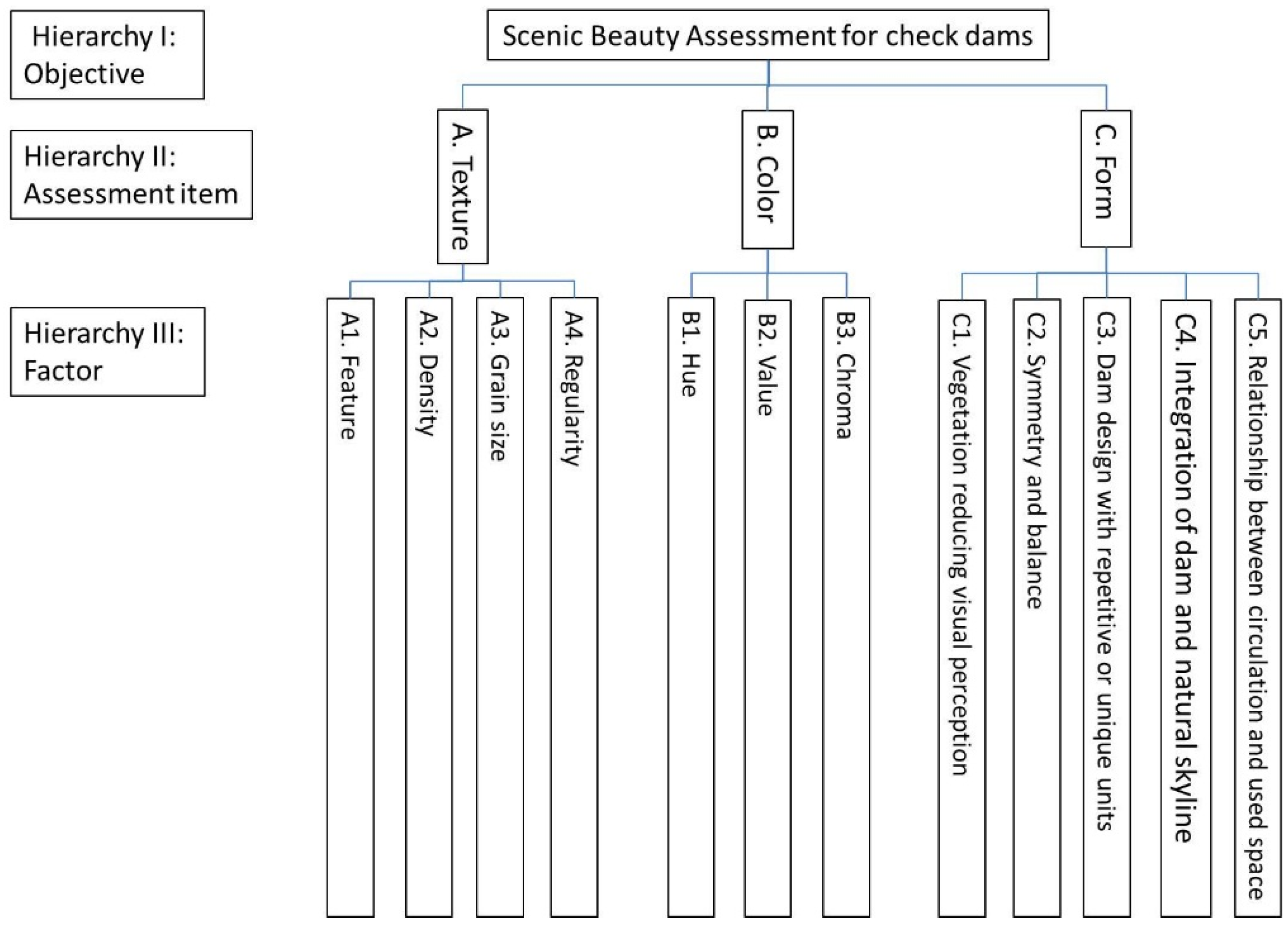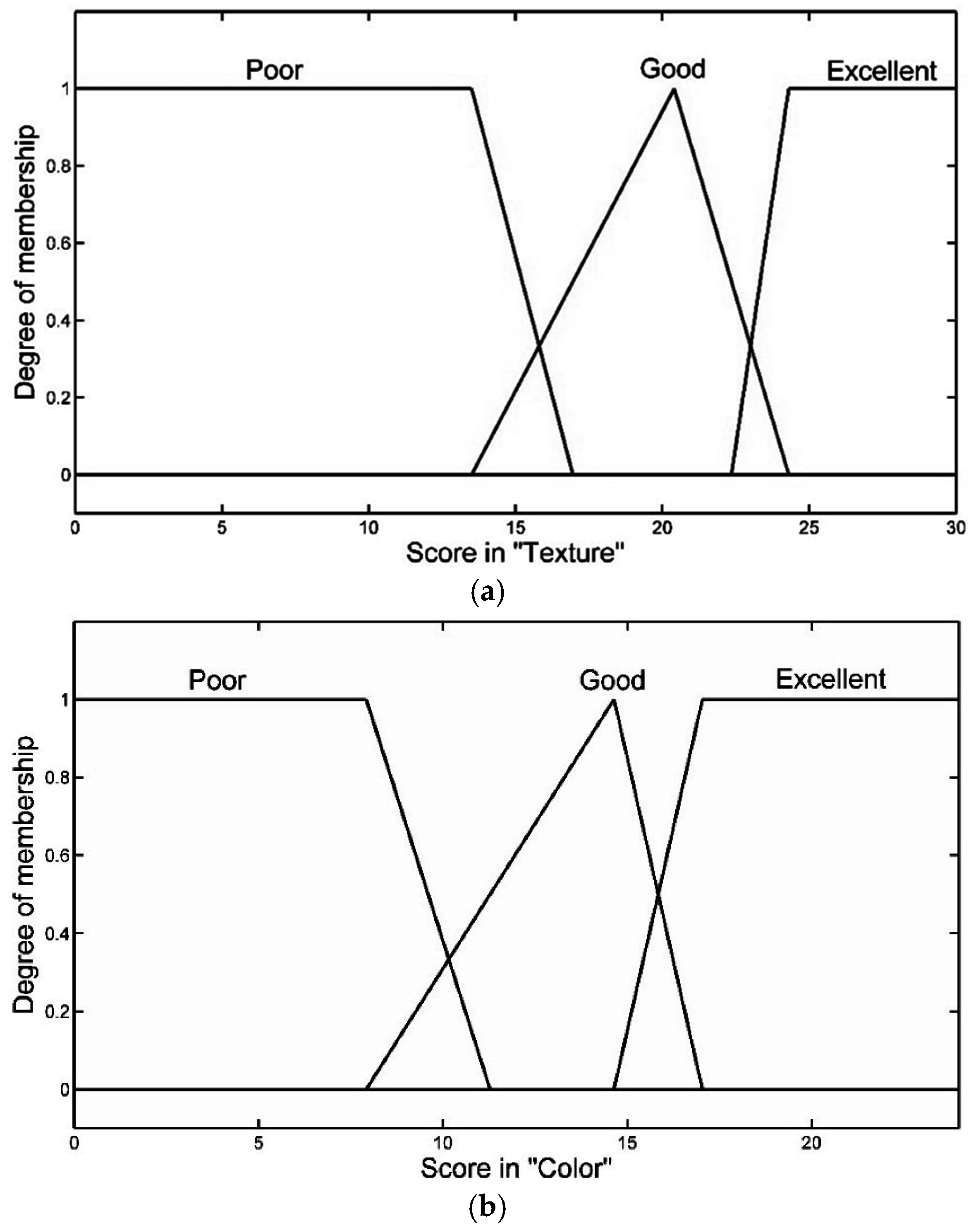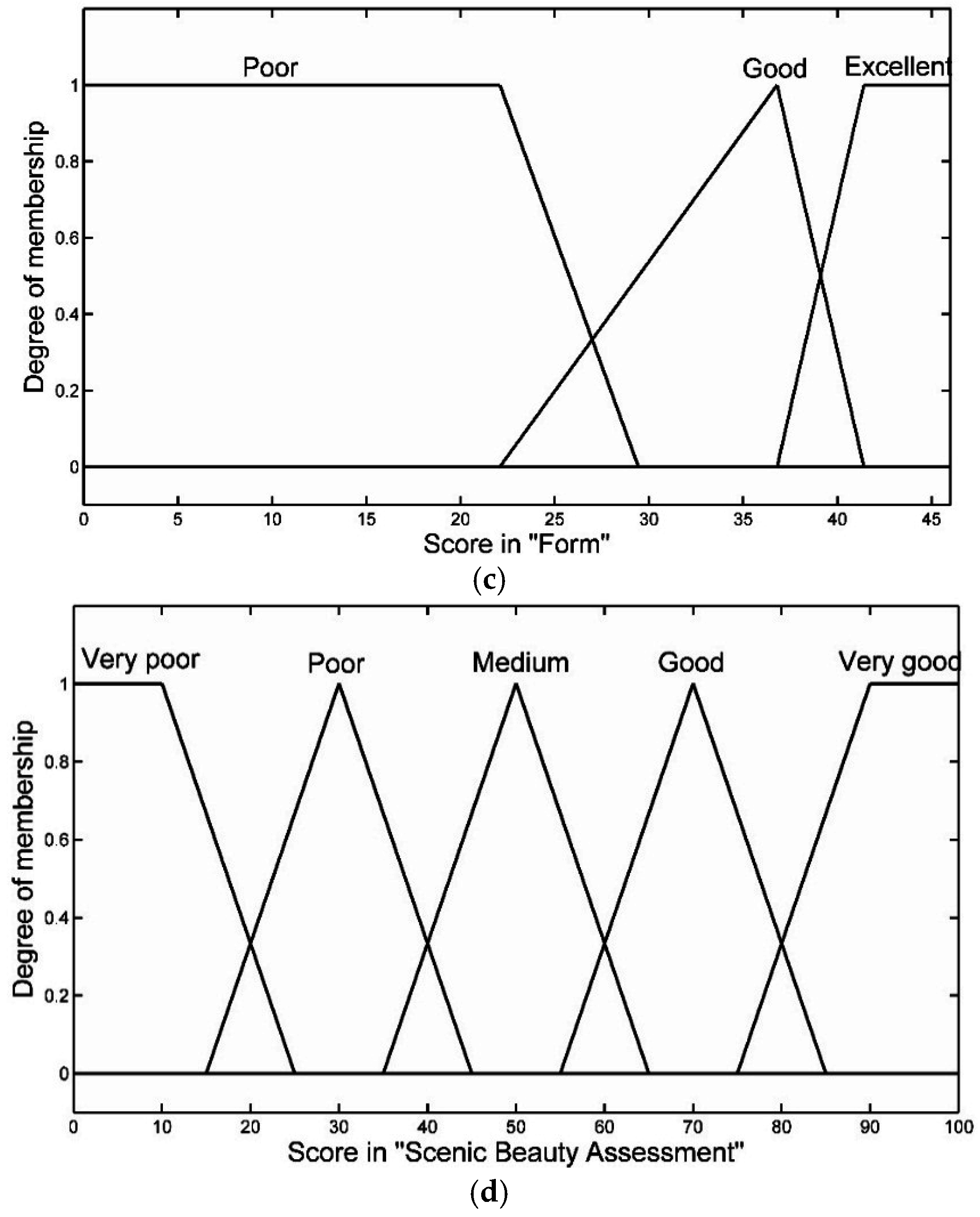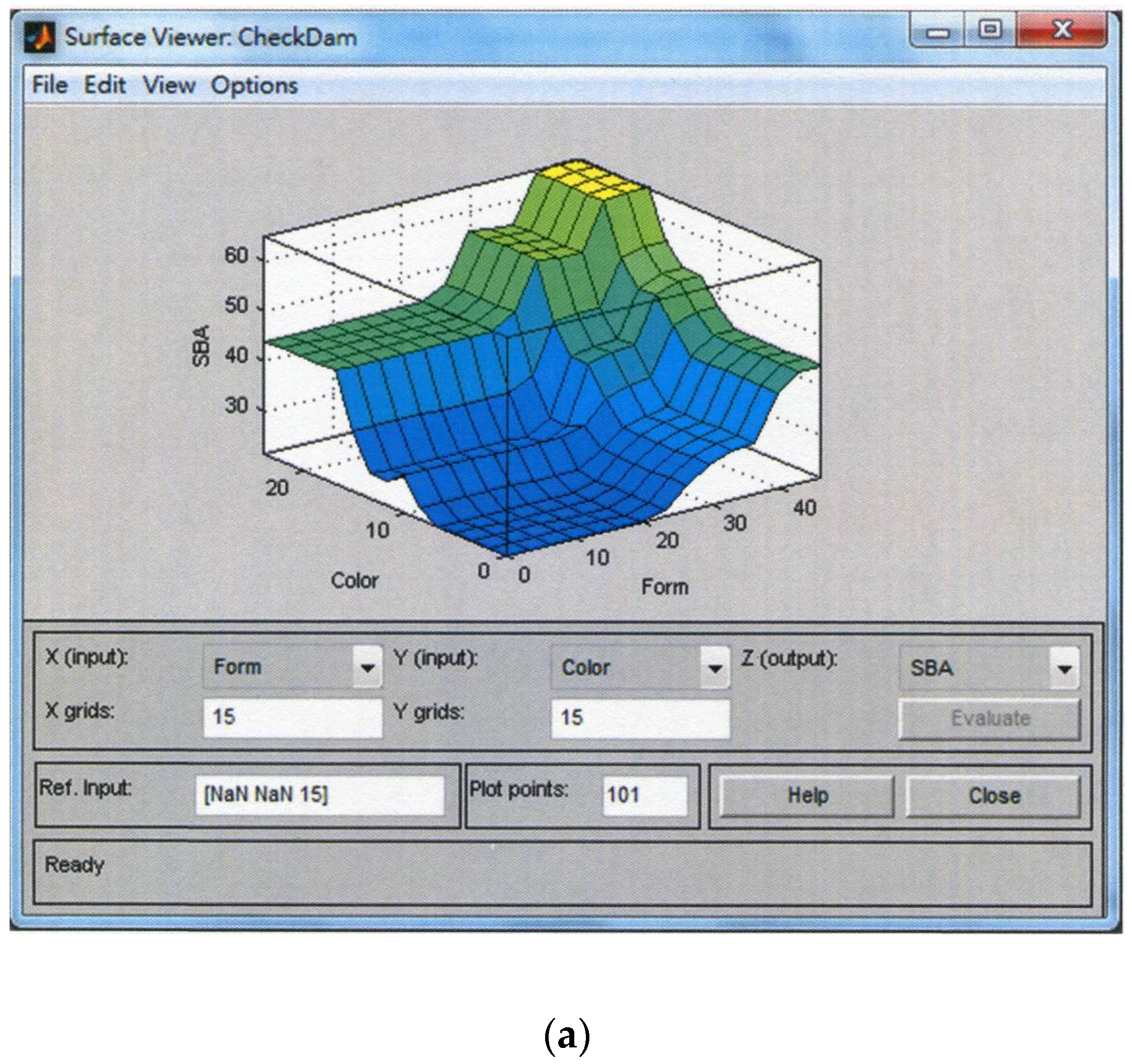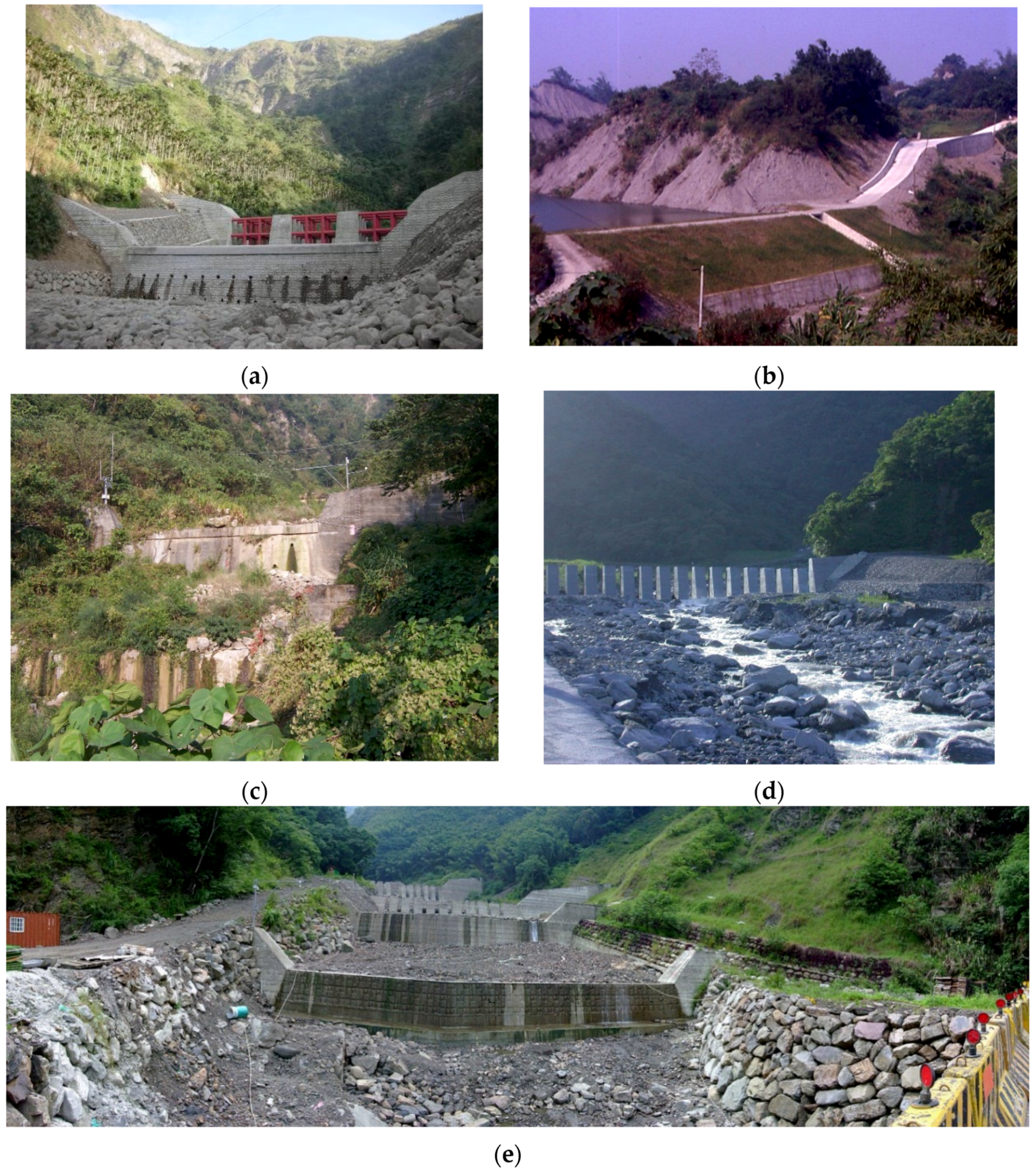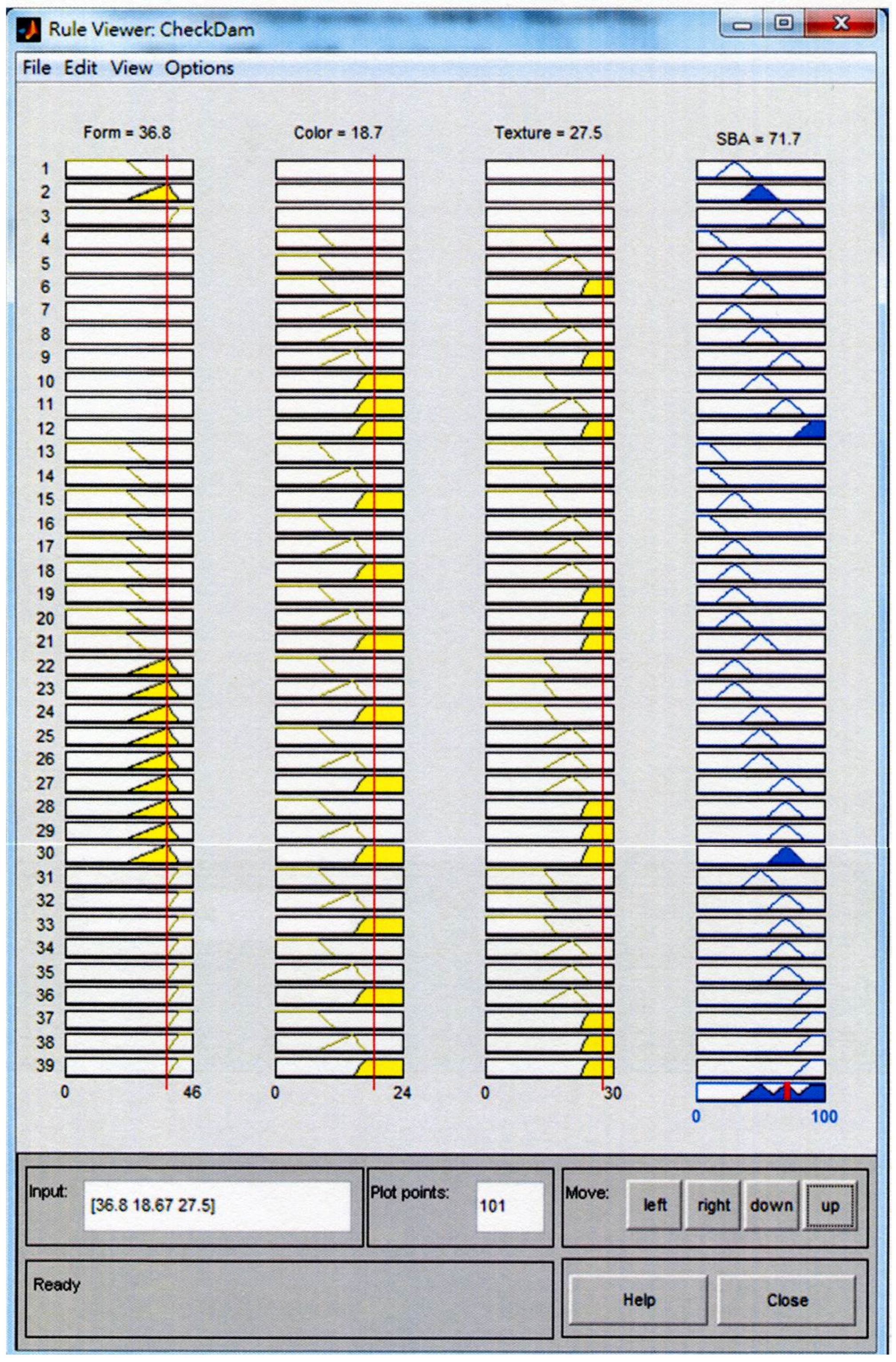2.1. Analytic Hierarchy Process
The Analytic Hierarchy Process (AHP), proposed by Thomas Saaty, has become a common decision-making tool for various applications [
20,
21,
22,
23,
24,
25,
26]. Its use is divided into the establishment of hierarchy and the assessment of hierarchy. With AHP, the elements of complex problems are assessed by experts and then presented through simple hierarchical structures, which are further evaluated with scales for subsequent paired comparison and matrix establishment. Eigenvectors are then used to compare the priority of elements in hierarchies. Finally, the consistency of the paired-comparison matrix is tested for reference. According to the paired comparison used to establish the matrix
A,
aij is the compared value between
i and
j, while the diagonal shows the self-comparison of elements that have a value of 1. The upper right values in the matrix are the comparison results of the questionnaire, while the lower left values are the reciprocals of the upper right values,
i.e.,
aji = 1/
aij.
When the paired-comparison matrix is established, the eigen vector and the maximum eigen value are calculated to establish the weight. Saaty proposed the following approximate steps for acquiring the eigenvector: (1) average of normalized columns; (2) normalization of row average; then (3) normalization of the column reciprocal average; and (4) normalization of the geometric mean of the rows [
22,
23]. Based on the characteristics of MatLAB suitable for the computation of vector matrices, window-interfaced programming codes are self-developed for this study. These utilize the functions built into MatLAB for directly calculating the eigenvalues and eigenvectors as well as selecting the maximum eigenvalue and the corresponding eigenvector as the weight. Having calculated the vector, a consistency test is applied, including the calculation of consistency index (
C.I.) and consistency ratio (
C.R.):
where
is the maximum eigenvalue;
n is the matrix rank; and
R.I. is the random index, which is the randomly generated consistency index of the matrix and is related to the rank of matrix, as Saaty suggested in
Table 1 [
22]. Saaty considered that the comparison was randomly generated as
C.R. approached 1, and that greater consistency appeared as
C.R. approached 0. Generally,
C.R. 0.1 is acceptable. The weight of the overall hierarchy can be further calculated and tested for consistency after acquiring the relative weight between elements.
The current study is based on previous studies [
13,
27,
28] that used the Scenic Beauty Assessment (SBA) criteria to evaluate check dams with expert questionnaires, and the hierarchy of the evaluated factors is depicted in
Figure 1. Implementation of the expert questionnaire is divided into Phase 1, for clarifying the importance of factors with the Delphi Method used to collect the opinions for the reference in the next step; and Phase 2, for evaluating the relative importance of the assessment items in order to determine the hierarchical matrix in AHP. MatLAB programming language is utilized for self-developing a Windows-interfaced program to calculate the eigenvalues, eigenvectors,
C.I., and
C.R. of the paired-comparison matrix as well as to directly calculate the weights between factors.
Table 1.
Values of random index
R.I. [
13].
Table 1.
Values of random index R.I. [13].
| Rank | 1 | 2 | 3 | 4 | 5 | 6 | 7 | 8 | 9 | 10 |
|---|
| R.I. | 0.00 | 0.00 | 0.58 | 0.90 | 1.12 | 1.24 | 1.32 | 1.41 | 1.45 | 1.49 |
Figure 1.
Structure of landscape assessment factors in check dam.
Figure 1.
Structure of landscape assessment factors in check dam.
2.2. Fuzzy Logical System
Traditional Boolean logic has obvious limits. For example, a grade over 60 points might be needed to pass a course, which would be failed with less than 60, even though there is actually not a large difference between 61 and 59. In such a case, experts would generally apply common sense and use ambiguous language for solving problems. To overcome these limits, fuzzy control has two main advantages: (1) not requiring accurate mathematical models; and (2) being able to combine expert knowledge with the fuzzy system designed on computers [
29,
30,
31,
32]. When applying fuzzy control, the system is described with fuzzy rules, which use linguistic fuzzy information, rather than mathematical equations. As a result, expert knowledge could be transformed into fuzzy control rules to reduce the design complexity of expert assessment system. In this study, the expert questionnaires organized using AHP are utilized for establishing the fuzzy rules, and the Fuzzy Logical Toolbox in MatLAB is applied to establish the logical system.
Based on previous studies [
27,
28,
33,
34] and the results of our Expert Questionnaire Survey, the Scenic Beauty Assessment criteria for check dams and the fuzzy logic rules were determined. In addition, the Fuzzy Logical Toolbox [
35] in MatLAB was used to establish a Fuzzy Logical System for Scenic Beauty Assessment (see
Figure 2). Based on the research results of Chen & Lin [
13], the Scenic Beauty Assessment criteria are established. These include an assessment range for the Fuzzy Logical System, including poor, good, and excellent, which is based on the weights of texture, color, and form. The values of very poor, poor, medium, good, and very good are the resulting Scenic Beauty Assessment (0–100). The fuzzy set of texture, color, form, and Scenic Beauty Assessment is shown in
Figure 3, where the assessment range and the weights are further regulated based on results from the Experts Questionnaire Survey [
28]. Detailed illustrations are described in the next section.
Figure 2.
Flow chart of fuzzy logical system.
Figure 2.
Flow chart of fuzzy logical system.
Figure 3.
Fuzzy sets of fuzzy logical system: (a) fuzzy set of texture; (b) fuzzy set of color; (c) fuzzy set of form; (d) fuzzy set of Scenic Beauty Assessment.
Figure 3.
Fuzzy sets of fuzzy logical system: (a) fuzzy set of texture; (b) fuzzy set of color; (c) fuzzy set of form; (d) fuzzy set of Scenic Beauty Assessment.
The fuzzy rules are further established. Since this study involves the application of three inputs and one output, it is convenient to present the fuzzy rules with a
matrix for such a three-to-one system [
30]. Assuming that form receives the highest weight, form is first taken into account for the following rules.
If (form is excellent) then (Scenic Beauty Assessment is good)
If (form is good) then (Scenic Beauty Assessment is medium)
If (form is poor) then (Scenic Beauty Assessment is poor)
A 3
3 FAM (Fuzzy Association Memory) could be used for the remaining rules, as shown in
Figure 4a, where nine rules are acquired, from a total of 12 rules that form Rule Base 1. A cubic (3
3
3) FAM could be deducted for 27 rules that describe the complexity of all variables in the expert system, as shown in
Figure 4b. Rule Base 2 is further established. This completes the fuzzy rules for the Fuzzy Logical System.
After confirming the fuzzy rules for the expert system, the Fuzzy Logical Toolbox in MatLAB can be applied to determine the relationship between texture, color, form and Scenic Beauty Assessment (
Figure 5). When an assessment is required, the assessment scores for texture, color, and form can be input into the expert system to obtain the results.
Figure 4.
Setup rules for a fuzzy logical system: (a) presented with square FAM; (b) presented with cubic FAM and hierarchic cubic FAM.
Figure 4.
Setup rules for a fuzzy logical system: (a) presented with square FAM; (b) presented with cubic FAM and hierarchic cubic FAM.
Figure 5.
Relationship between texture, color, form and Scenic Beauty Assessment: (a) form, color, and Scenic Beauty Assessment; (b) form, texture, and Scenic Beauty Assessment; (c) color, texture, and Scenic Beauty Assessment.
Figure 5.
Relationship between texture, color, form and Scenic Beauty Assessment: (a) form, color, and Scenic Beauty Assessment; (b) form, texture, and Scenic Beauty Assessment; (c) color, texture, and Scenic Beauty Assessment.
Referring to the items in
Figure 1, the assessment reference is drawn as shown in
Table 2, which could be used for the assessment when applying this expert system. The Scenic Beauty Assessment is calculated with the fuzzy rules from the previous fuzzy expert theory, rather than directly adding the scores for texture, color, and form. In Fuzzy Theory, there is a fuzzy space between assessment levels, so the evaluator could provide a general score by referring to the table, which is further regulated by the expert system, without concern for errors.
Table 2.
Criteria of landscape assessment for check dam.
Table 2.
Criteria of landscape assessment for check dam.
| Item | Detail | Evaluation Criteria |
|---|
| A. Texture | A1. Feature: Texture feature on dams | Using natural materials similar to local landscape for the dam body (3 points) |
| Using similar texture to natural materials for the dam body (2 points) |
| Artificial vein lines of the dam body not matching the environment (1 point) |
| A2. Density: Density difference between object and background | Continuity between object and background density (3 points) |
| Discontinuous diversification between object and background density (2 points) |
| Compatibility contrast between object and background density (1 point) |
| A3. Grain size: Grain size difference between object and background | Continuity between object and background grain size (3 points) |
| Discontinuous diversification between object and background grain size (2 points) |
| Compatibility contrast between object and background grain size (1 point) |
| A4. Regularity: Similarity regularity between object and background | Visual continuity (3 points) |
| Visual discontinuous diversification (2 points) |
| Visual compatibility contrast (1 point) |
| B. Color | B1. Hue: Blue, green, yellow, red, and purple as the representative | Yellowish-brown color, green color (3 points) |
| Reddish-yellow color (2 points) |
| Other colors (1 point) |
| B2. Value: 0~10 (0 for black; 10 for white; 5 for standard gray) | Similar to Forest Value 7.5~8.5 (3 points) |
| Similar to Grassland Value 7~8 (2 points) |
| Similar to Sand land Value 7.5~9 (1 point) |
| B3. Chroma: Levels 0~20 (the higher level shows the higher brightness) | Similar to Forest Chroma 2~4 (3 points) |
| Similar to Grassland Chroma 1~4 (2 points) |
| Similar to Sand land Chroma 1~4 (1 point) |
| C. Form | C1. Vegetation reducing visual perception: Percentage of vegetation in the evaluated image | Flourishing vegetation to cover most parts of dam body (3 points) |
| Vegetation to cover some parts of dam body (2 points) |
| Little vegetation to cover the dam body (1 point) |
| C2. Symmetry and balance: Symmetry refers to same visual form on both sides of the axis; balance refers to different forms on both sides of the axis. | Same visual form on both sides of the axis (3 points) |
| Different forms on both sides of the axis, but conforming to the harmony force field of the form (2 points) |
| Different forms on both sides of the axis (1 point) |
| C3. Dam design with repetitive or unique units: When the structure is composed of repetitive units, it is relative dull. | Mostly using unique units different from forms with repetitive units (3 points) |
| Less using unique units different from forms with repetitive units (2 points) |
| Merely using several repetitive units (1 point) |
| C4. Integration of dam and natural skyline: The vertical and horizontal outlines of dam body largely different from the background (landscape) receive lower scores, and vice versa. | Similar outline of dam body to the skyline with more than four tangent lines (3 points) |
| Similar outline of dam body to the skyline with 1–3 tangent lines (2 points) |
| Low similarity between the outline of dam body and the skyline (1 point) |
| C5. Relationship between circulation and used space: The visual perception depends on the relationship between the circulation of people and cars and the dam site, the used space on both banks. | People and car circulation allowing close view of the dam, and the used space on both banks designed water-friendly facilities or landscape (3 points) |
| People and car circulation not allowing close view of the dam, but the used space on both banks designed water-friendly facilities or landscape; or people and car circulation allowing close view of the dam, but the used space on both banks not being designed water-friendly facilities or landscape (2 points) |
| People and car circulation not allowing close view of the dam, and no design of water-friendly facilities or landscape for the used space on both banks (1 point) |
